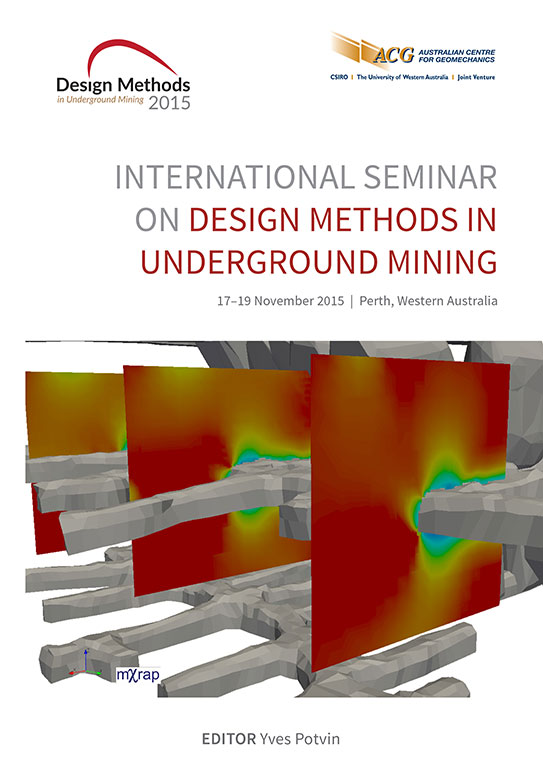Geotechnical approach to stope and pillar optimisation at Granny Smith Mine

|
Authors: Machuca, L; Sutton, M; Grow, R; Andrews, P |
DOI https://doi.org/10.36487/ACG_rep/1511_10_Machuca
Cite As:
Machuca, L, Sutton, M, Grow, R & Andrews, P 2015, 'Geotechnical approach to stope and pillar optimisation at Granny Smith Mine', in Y Potvin (ed.), Design Methods 2015: Proceedings of the International Seminar on Design Methods in Underground Mining, Australian Centre for Geomechanics, Perth, pp. 215-232, https://doi.org/10.36487/ACG_rep/1511_10_Machuca
Abstract:
The initial determination of the rock mass characteristics and its behaviour has been a key parameter to ensure that a safe and economical extraction can be achieved at Granny Smith Gold Mine (GSGM). The objective of this paper is to outline the geotechnical and planning approach that has been followed to ensure that the intended stoping performance is reached. The geotechnical analysis involves the use of geological and structural analysis, empirical design methodologies and numerical analysis/simulation to determine the effects of induced stresses on the overall stability of the open stopes as well as to the adjacent excavations. Stope and pillar design, size and placement are optimised with the aim to maximise extraction without compromise to personnel safety and global mine stability. The reinforcement requirements for accesses and adjacent excavations to the stoping areas are determined at the planning stage with the aid of numerical modelling.
References:
Barton, N 1974, ‘A review of the shear strength of filled discontinuities in rock’, Norwegian Geotechnical Institute, no. 105, 38 p.
Deere, DU 1964, ‘Technical description of rock cores for engineering purposes’, Rock Mechanics and Engineering Geology, vol. 1, no. 1, pp. 17-22.
Gold Fields Australia 2011, Feasibility study: Wallaby Deeps Zone 90, internal report, no. BGS-WAD-FS-001, Gold Fields Australia, Perth.
Gold Fields Australia 2013, Feasibility study: Granny Smith Zone 100, internal report, Gold Fields Australia, Perth.
Lang, B, Pakalnis, R & Vongpaisal, S 1991, ‘Span design in wide cut and fill stopes at Detour Lake Mine’, Proceedings of the CIM 93rd Annual General Meeting, Canadian Institute of Mining, Metallurgy and Petroleum, Westmount, QC, paper no. 142.
Lunder, J 1994, ‘Hard rock pillar strength estimation an applied empirical approach’, Master of Science thesis, University of British Columbia.
Mathews, KE, Hoek, E, Wyllie, DC & Stewart, S 1981, Prediction of stable excavation spans for mining at depths below 1,000 metres in hard rock / Golder Associates, CANMET Library & Documentation Services Division, Vancouver.
Milne, D 1997, ‘Underground design and deformation based on surface geometry’, PhD thesis, University of British Columbia: Vancouver.
Milne, D & Pakalnis, R 1997, ‘Theory behind empirical design techniques’, Proceedings of the 12th colloque en controle de terrain de l'Association Miniere du Quebec, Val d'Or, Quebec.
Nickson, SD 1992, ‘Cable support guidelines for underground hard rock mine operations’, Master of Science thesis, University of British Columbia.
Potvin, Y 1988, ‘Empirical open stope design in Canada’, PhD thesis, University of British Columbia.
Rauert, NS 2012, ‘Wallaby Deeps – from the optimal opportunity to reality’, Proceedings of the Narrow Vein Mining Conference, The Australasian Institute of Mining and Metallurgy, Melbourne, pp. 207-214.
Villaescusa, E 2004, ‘Quantifying open stope performance’, in A Karzulovic & M Alfaro (eds), Proceedings of the International Conference and Exhibition on Mass Mining (MassMin 2004), Instituto de Ingenieros de Chile, Santiago, pp. 96-104.
© Copyright 2025, Australian Centre for Geomechanics (ACG), The University of Western Australia. All rights reserved.
View copyright/legal information
Please direct any queries or error reports to repository-acg@uwa.edu.au
View copyright/legal information
Please direct any queries or error reports to repository-acg@uwa.edu.au